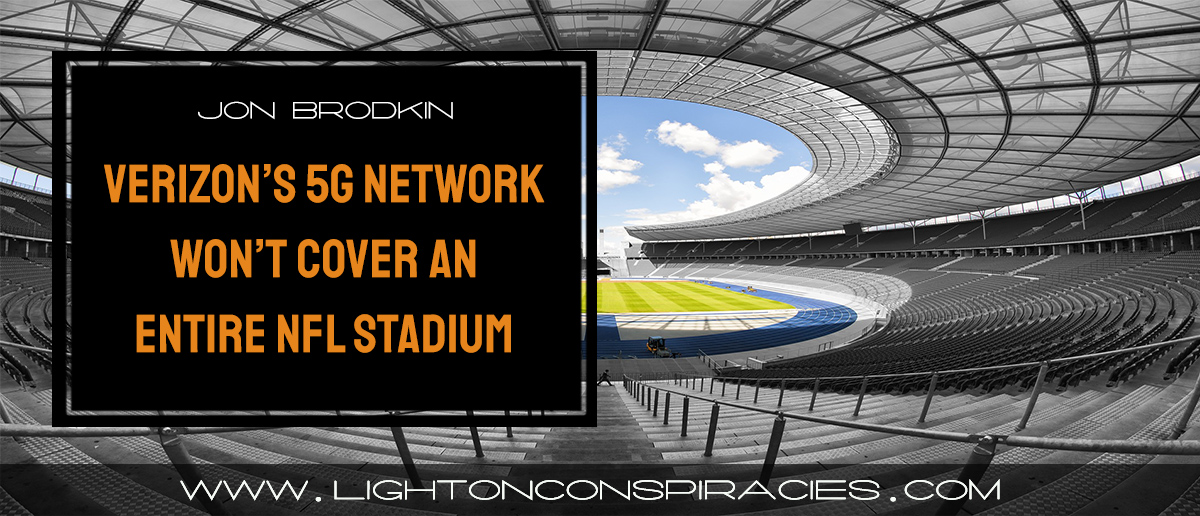In-stadium 5G only reaches some seating sections and some concourses and gates.

Verizon yesterday announced that its 5G service is available in 13 NFL stadiums but said the network is only able to cover “parts” of the seating areas. Verizon 5G signals will also be sparse or non-existent when fans walk through concourses and other areas in and around each stadium.
The rollout of 5G is more complicated than the rollout of 4G was because 5G relies heavily on millimeter-wave signals that don’t travel far and are easily blocked by walls and other obstacles. While Verizon is trying to build excitement around 5G, its announcement for availability in NFL stadiums carried several caveats.
“Verizon 5G Ultra Wideband service will be available in areas of the [13] stadiums,” Verizon said. “Service will be concentrated in parts of the seating areas but could be available in other locations in and around the stadium as well.”
BOOK AD
Yolanda Yogapanda
by Ole Dammegard
Yolanda Yogapanda is a very smart and wise little panda bear. Together with her best friends, Toby Trunk and Leopold the stripy lion, she encounters various challenges in life – challenges Yolanda Yogapanda usually have great ways of solving. This is the first in a series of children’s books (age 5-95 years) based on the wisdom of ancient and timeless teachings of great yoga masters like Patanjali and Sri Swami Satchidananda.

Notice the phrase “could be available” in that last sentence. Verizon isn’t promising any 5G coverage outside the seating areas, and the seating-area coverage will only be available in some sections.
When contacted by Ars, Verizon said that its 5G coverage “varies by stadium” but provided no specifics on how widespread the coverage is in each facility. At least some of the 13 stadiums don’t have any 5G coverage available outside the seating areas, Verizon also acknowledged.
“Our main focus is to provide 5G Ultra Wideband service to fans when they are in their seats,” Verizon told Ars. “In some stadiums we also have 5G available in the concourse areas and by the entry gates.”
Verizon also said it plans to “expand to more stadiums during this season” and “increas[e] coverage in the 13 stadiums that currently have 5G.” But Verizon did not tell us if it expects to reach full-stadium coverage in any of the NFL facilities, and it didn’t answer our question about whether the in-stadium limits are due to the use of millimeter-wave frequencies or some other factor.
Same problem in early launch cities
This is the same problem, on a smaller scale, that Verizon’s network experienced in early 5G launch cities. You had to be near a 5G antenna to get a signal, and reviewers had trouble staying connected to the 5G service.
Verizon’s stadium announcement explained that customers’ phones will fall back to 4G automatically and that in some cities, there isn’t any 5G coverage at all outside the stadiums:
When customers with 5G enabled smartphones move outside Verizon’s 5G Ultra Wideband coverage area, the 5G-enabled devices will transition the signal to Verizon’s 4G network. In some cities the stadium will be the only place with Verizon 5G Ultra Wideband service, offering fans a unique 5G experience they can’t get anywhere else in their local area.
5G can work on any frequency used by mobile networks, including the lower-band frequencies Verizon uses for its nationwide 4G network. But Verizon has said that customers will only notice small speed increases on 5G when it’s delivered over low-band frequencies. The big speed increases will come on millimeter-wave deployments, which will be concentrated in densely populated areas.
The 13 stadiums where Verizon 5G is partially available include those used by the Carolina Panthers, Denver Broncos, Seattle Seahawks, Detroit Lions, New England Patriots, Miami Dolphins, Indianapolis Colts, New York Giants and New York Jets (they share a stadium in New Jersey), Baltimore Ravens, Houston Texans, Chicago Bears, and Minnesota Vikings. That’s only 12 stadiums, so there’s a 13th that Verizon hasn’t revealed. There are another 18 NFL stadiums without Verizon 5G service.
AT&T also yesterday announced millimeter-wave 5G for NFL fans, but only at the AT&T Stadium used by the Dallas Cowboys. It sounds like the coverage will be better than Verizon’s, as an AT&T spokesperson told us that its 5G at AT&T Stadium “include[s] all of the non-suite seating sections, the plaza areas, and the field itself.” (This is real 5G, not AT&T’s rebranded 4G.) But unlike Verizon’s NFL deployment, AT&T’s is only available at one stadium so far.
The reality of 5G has so far fallen short of the hype stoked by carriers and Federal Communications Commission officials, who have claimed 5G is so revolutionary that the usual rules and regulations shouldn’t apply to its rollout.












